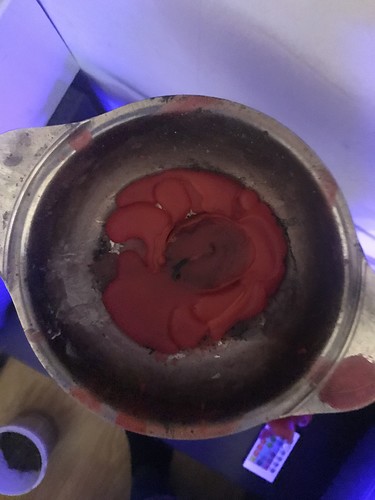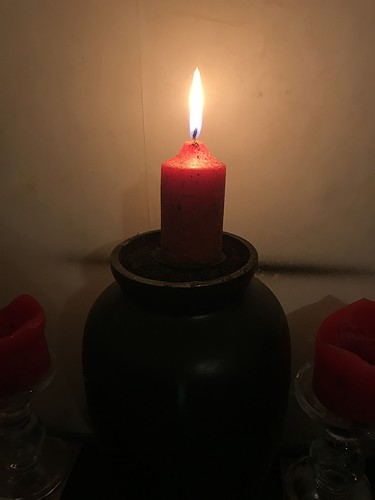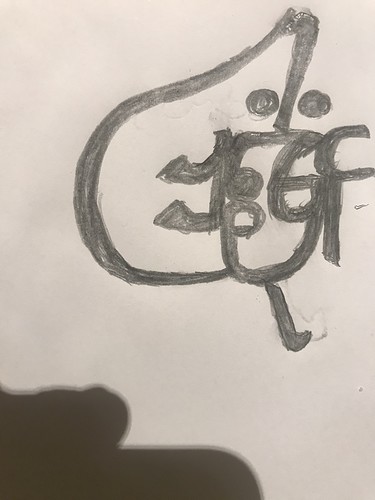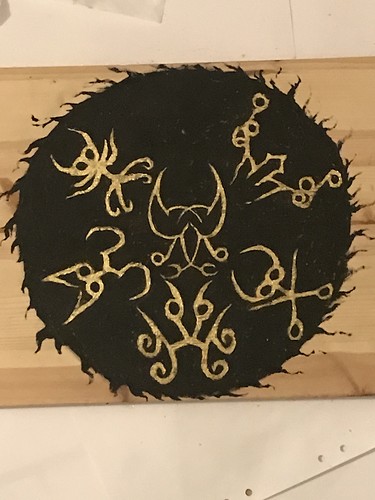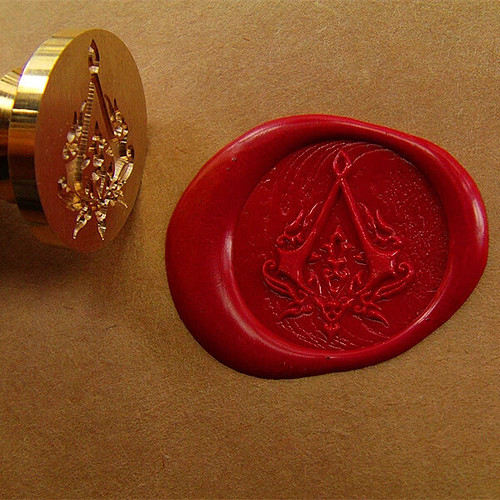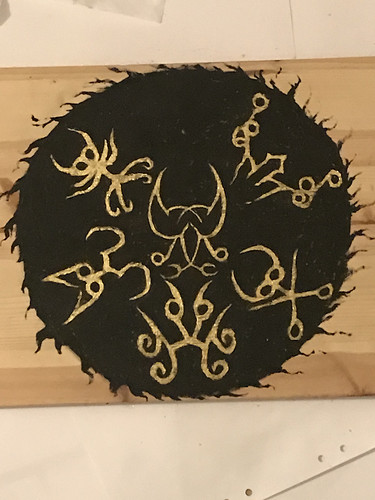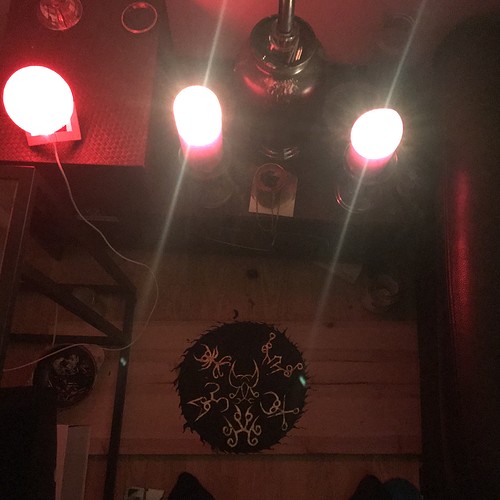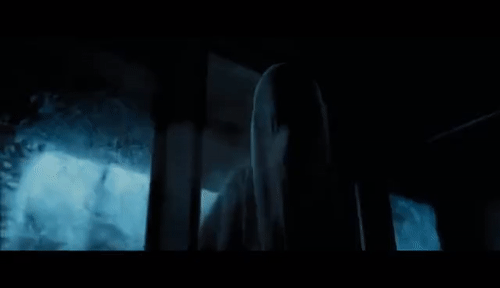The creation of a lamp of fate
Date: 2020-11-13
List of terms you should know reading this journal from here on out;
Amesha spenta = angels of Ahura Mazda the Zorastrian God of light (false light for the Zanda), order and wisdom (Joseph, 2017).
Angra Mainyu = evil inspiration another name for Ahriman (Joseph, 2017). FYI he has 101 more.
Div = devil or demon (Joseph, 2017).
Druj = demoness (Wikipedia, 2020). Druj also means: unprincipled, dishonest, harmful, chaothic, unlawful and living by the lie - deceiving and deluding others (heritage institute, 2005). That’s why in the consecration rite (a staor) we say; I proclaim myself as dregvantem, a child of the lie which is the truth of becoming. As unlike the children of Ahura Mazda; the asha. We use chaos and disregarding of rules and limits of creation Mazda to evolve instead of residing in stasis and slavery. We use creation as fuel to become more to evolve beyond our limits.
Domar & Dehakh = basically the twin serpents of Yogic traditions (like Kundalini Yoga), these twin serpents can be viewed as similar to the kundalini (the fire serpent) or idaho and pingala (please excuse the spelling for this). They represent the kunda force (the dragon force) , which turns man or woman into div. Each of the twin serpents represents a magickal path and principle. As in they represent the path of black alchemy and the path of sorcery. Both coalesce and meet at some point traversing each path (Joseph, 2017).
Dregvantem = those who live by the druj (Heritage institute, 2005).
Nasu = falsehood (Wikipedia, 2020).
Pahlavi alphabeth = it’s a really old pre-persian alphabeth, I guess it’s even considered to be proto persian. It’s older than the Avestan alphabeth which is was the precursor to the persian alphabeth and is an development of it. There are different form of the Phalavi alphabeth, as in one form it was used for carving, another form of it was used for something else. You can find the additional info through the use of google (Wikipedia, u.å.).
Staot = technically similar to incantation but it’s sonic spells, words of power with intelligble meaning which you focus on an intent that cause either an atmospheric shift. The said shift to make the temple and environment more conduscive to the spell you want to cast. It can also be used for spell by themselves (Joseph, 2017).
Zanda = priest/priestess (Joseph, 2017). Note: I am unsure if Zanda also applies to priestess as I haven’t found any mention or variation for the title of a priestess in the grimoire, yet.
There are more but these will do for a start.
Notes: technically I lied before when I said that today was the day the I’ve created my first lamp of fate. The more accurate versions of the story is that I tried to create using a candle mold and parafin wax. Let’s just say the first tries became rather messy as I hadn’t bothered reading up on the simple fact that you need adheasive to ensure that the wax won’t run out of the mold. Which is a pretty obvious in hindsight however I thought having a thick enough of a wick would block the melted parafin wax thus preventing it escaping the mold, it didn’t.
The lamps of fate are technically beacons (candles) that are lit to channel the power of the denizens of Arezura; the divs and the druj, thereby defiling the creation of Ahura Mazda, defying fate and imposing the will of the Zanda molding the limits of creation. In its (the lamp of fates’) creation you harness the powers of creation and destruction (Joseph, 2017). I won’t detail all of the steps but some of them doing so would be copyright violation. In order to create a lamp of fate you first need to figure out the purpose for creating one, it could be anything. During the lamps creation you focus on that specific intent for making while you make up until you let it cool off.
Here’s what you do to create your own candles in general;
Either get paraffin wax or beeswax if you want to (it’s expensive). You get a jar or you cut something out of plastic that’s round. Then you melt left over wax from other candles,or in the case of bought candle wax, melt it and then add either color pigments in there or add any natural compound like coal f.e. to make a candle black. I took the safe route and bought color pigmentation, in the package wicks were included. If you use a candle mold then the wick should be twice the length of the candle, tie a knot at the narrow, not too hard you want to be able to to untie it once the wax has hardned, and finally add the adheasive around the narrow end and cover it completly, knot and all. Twine the remaning amount of the wick around f.e. a toothpick or an object that can be placed in the middle of the the jar, sirup container or mold (the big round open end) while reaching the edges of the container. This part about the wick should be done before melting the wax. Melt the wax add the coloring then pour the melted wax into the mold, jar etc. and then let it sit there and cool off.
Once done when it’s been cooled off, then you can either put it in the fridge for about an hour or flush warm water around the container, while removing the candle out of the mold/container. Once removed from there you now get to enjoy the fun part consecrating it and finally in due time use it.
Here on are a couple of differences from this and other paths. One have already been mentioned above as in the usage of the principles of creation and destruction in the lamps creation. You’ve utilized creation already here coms the other part.
Once the candle ready. You bring the candle before your altar, if you want ways to circumvent an altar speak with Kurtis Joseph as well as for additional details regarding the lamps of fate. The candles of Domar and Deehakh two red candles the one to the left of the altar urn and then the one to the right. This is done before all rites of sorcery on the path, then you recite rawanuah (a dark staot of opening similar to the LBRP in western tradition) found on page 94-95. Then once done I like to recite the rite of consecration (a staot). That staot is found on page 96-97 in the grimore of the Black Magick of Ahriman, note you don’t have to use this but I simply do it as an preemptive measure to remove potential blocakges. The rite of consecration is recited to break the limits of its mold that binds the candle (or any object) and allow the energies of the hell realms to break the hold of Ahrua Mazda and the Amesha Spentas over it (Joseph, 2017). Then after that’s done you should prepare a note that fits inside you palms, where you write all that limits the success of the ritual f.e let’s say you create a candle for exacting vengence or incite hatred in others, then recite all that stops you from doing so on the note. Sit before the blackened fire of Zohakh (Azi-Dahakah) and hold the hands in a prayer mudra while visualizing those limits being consumed by the blackened fire (Joseph, 2017). Once you reach a certain point when it clicks for you so to speak (I won’t reveal the actual sensation, get Kurtis’s grimoire of that), you burn the note in the flame of the blakened fire and scatter the ashes on the altar. Then you inscribe symbols or glyphs on the candle. In my case I used a planetary symbol of Mars on one side, including a glyph from stringing together various letters of the Pahlavi alphabeth. I used the same base as I would creating sigils in general. Here’s what it looked like:
This is pretty raw I know. I’ll clean it up and I’ll post a new image of it some other day.
You inscribe this (the glypth) on the candle that will be your lamp of fate. Then you offer the candle your blood and addional herbal links or oils on it (my tip is to consecrate them to, using the ritual found on page 141-142; read the additional info beforehand by the way). Then you bury it (the candle) inside the altar urn underneath the blackened fire of Zohakh. For an X number of days relating to the working. I assume Kurtis means in relation to the number of days relates to a planet, this I can’t say is true. I’ll bury my candle for three days to a maximum of seven days to follow the classic planets. Since I want destruction of my enemies and exact vengence albeit premptively. I believe that Friday might correspond to a Div called Tarromat (this is UPG so far), as this Div rules over the sacral chakra which among other things relates to creativity and passion; in this case dark passion. I’ll dig it up on tuesday on the day of mars. Note: as you have buried it inside the altar urn you say an incantation which is found on page 262 in the grimore, laying your hand ontop the earth, once done place the black canlde on there (the blackened fire of Zohakh.
What remanins now for me is to wait for the candle to be infused with the power for it’s purpose, while in the meantime I’ll also start creating a new one, perhaps a black or pink one. While also having fun using the 101 names of Angra Mainyu. When I have the money I’ll attempt to get the materials for the creation of the candle of decay. However, what exactly that is and the process that goes into its creation is for another update some other day.
P.S. I’ll also attempt to get hold the Avesta, holy book of the Zorastrians as that will come in handy at some point during this pathworking.
Until then I wish you all the best.
References
Heritageinstitute. (2005). Zorastrianism: overview expanded. Date 2020-11-13 from Zoroastrianism Overview. Zoroastrian, Zoroaster, Zarathushtra, Zarathustra, Mazdayasni, Mazdayasna
Jospeh, K. (2017). Black Magick of Ahriman: the ancient rites, spells & demons of persia. Become a Living God: U.S.A.
Wikipedia. (2020). Nasu. Date 2020-11-13 from Nasu (Zoroastrianism) - Wikipedia


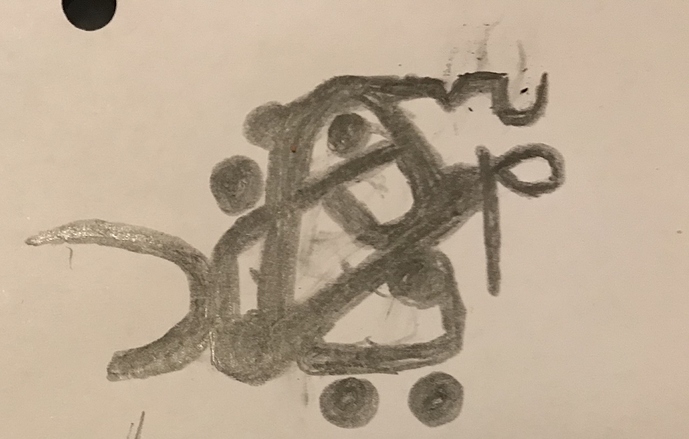
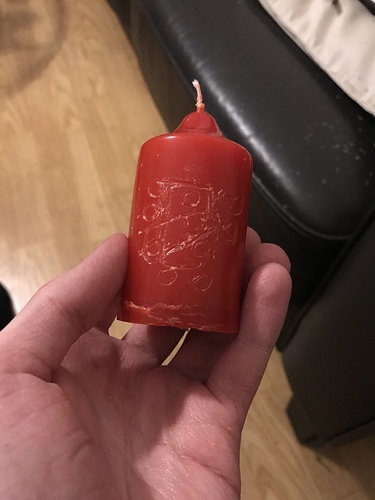
 but maybe you want it.
but maybe you want it.
 I will make good use of it for sure
I will make good use of it for sure 
